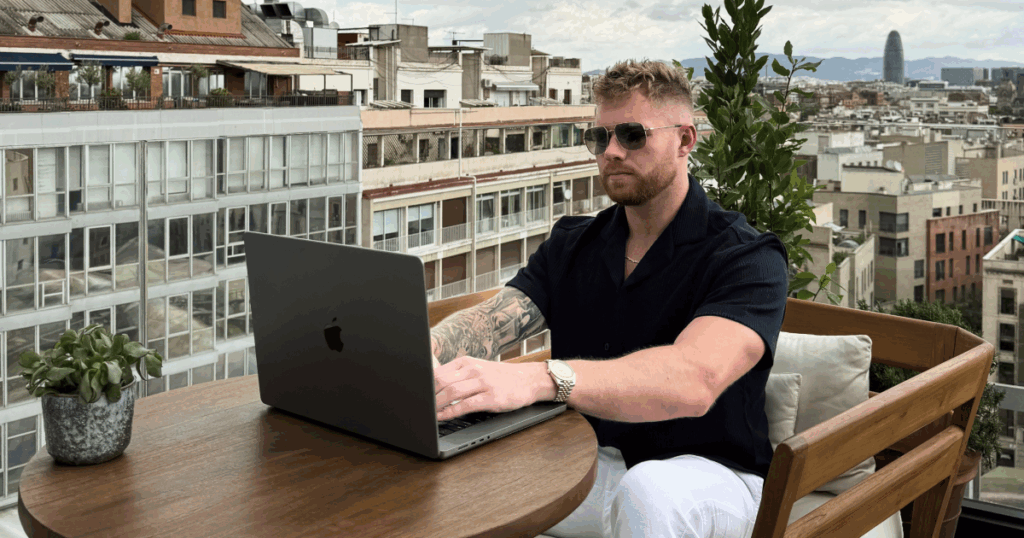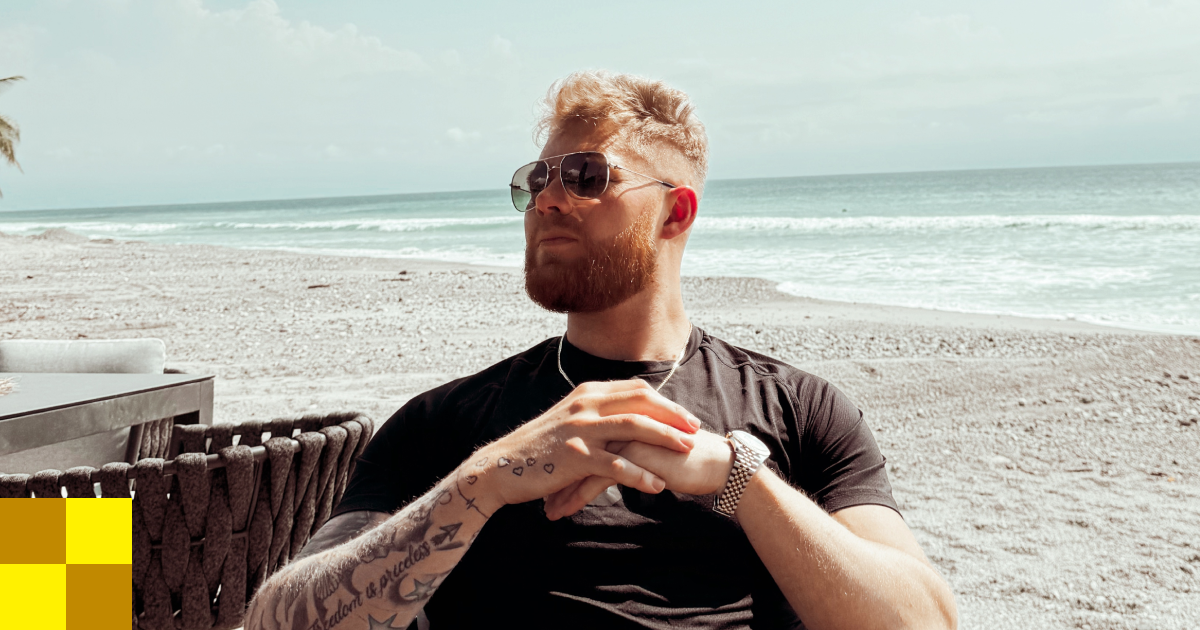“I went from some clueless college kid with no f&$*#g idea what he was doing into being responsible for 18 people, making sure their families can pay the bills each month.” Justin Saunders doesn’t just coach business owners; he lives for helping people win.
For him, pushing the boundaries of leadership and sales isn’t just a career. It’s the mission.
With so many people fighting not to be a part of the 9-5 grind, Saunders was looking for a way to break from the norm of a job market held at the whims of a job reality that’s changing by the day, thanks to constant advancements in literally every form of technology.
So why wouldn’t someone want to be their own boss?
The Backstory

A kid from Kentucky, Saunders first entered the sales field in 2015, while still in college. “I was selling print and digital ads and quickly became the top rep. That’s when it clicked: if I could figure out the fulfillment side, I wouldn’t just get 10% of the deal. I could build my own company.”
Fresh out of college with what he calls a “bullshit communications degree,” he closed the biggest deal of his young sales career: a local bowling alley buying the back page of a newspaper plus digital ads. Instead of celebrating or paying bills, he took that entire commission check and bought a social media marketing course from Tai Lopez.
Then he quit his job.
“I didn’t really have an option for failure in my mind,” he says. “I’m gonna learn something out of this.” He spent one weekend bingeing 8-12 hours of course content, convinced that if he could sell, he could figure out how to deliver. It was the kind of bet most people wouldn’t make, but most people don’t have 18 employees depending on them today.
Spoiler alert: his gamble paid off.
He built a successful agency, but after burning out and taking a break, he found himself fielding calls from friends who wanted advice. That’s when something shifted. “I realized that’s what I’m good at, helping others cut through the noise.”
Since then, Saunders has focused on scaling one company and building systems that work: simple, sustainable, and designed to grow.
Behind the Scenes

The reality of building something from scratch isn’t the highlight reel most people see on social media. While Saunders talks about betting everything on himself, the day-to-day grind was messier, failed ad campaigns that burned through cash, clients who blamed marketing when their sales process sucked, and the constant pressure of being responsible for other people’s livelihoods.
The entrepreneurship space is littered with people selling the dream of easy money and the laptop lifestyle, but Saunders learned early that sustainable growth means boring fundamentals:
- Tracking numbers
- Refining systems
- And having uncomfortable conversations with clients who aren’t ready to hear the truth about their business
It’s not the kind of content that goes viral, but it’s what separates legitimate businesses from get-rich-quick schemes masquerading as coaching programs.
The turning point for him wasn’t some polished, lightbulb moment; it was a gut decision, made with nothing but instinct and a final paycheck. “I didn’t have a backup plan,” he says. “I just knew I had to learn something from the risk, no matter how it turned out.”
Getting What You Want, but Not What You Need

The irony of Saunders’ success is that he got exactly what he thought he wanted, then realized he wanted the opposite. “When I first started online, my whole thing was like, Dude, I just want to get famous. I just want people to see me.” Now, spending $80,000 a month on ads and getting millions of views, he’s learned that quiet money beats loud money every time.
“I was so irresponsible with all of it,” he admits about his early success. “I looked at my bank account and was like, ‘What the fuck did all this go?'” The shift from seeking attention to avoiding it reflects a deeper understanding of what sustainable business looks like and why so many online entrepreneurs flame out after their first taste of success.
Looking back, he admits the timing was everything. “No wife, no kids, no mortgage; I was young and dumb and had a bullshit communications degree. There was nothing holding me back.” He figured worst case, he could always get another job. But the gamble paid off. That leap into self-education — and self-reliance — became the foundation for everything that followed. “I just bet 100% on myself,” he says. “And I kept going until I figured it out.”
One of the things that a lot of people don’t consider is the failure side. Even the best brands, people, and teams have sucked at one point or another. Saunders is honest and open about the parts of the equation that led to this point, using them as a badge of honor to signify how he has achieved a living with his company and his guidance.
“You don’t want to just come out and list everything you’ve messed up. But if you can turn those failures into lessons and pair them with the wins, that’s where the real value is. Life is polar: good or bad depends on how you frame it. What people really want to hear is what you learned and how it moved you forward.”
What Not to Do

“There’s a lot of things out in the space where it’s video, sales, letters, low ticket offers, Facebook groups, and things like that. We say, “Let’s turn your Instagram into a landing page.”
But then some people do not understand the business of social media; rather than just posting and hoping for the best, “It’s all about brand. If your brand isn’t dialed in, you won’t connect with the right people. Too many coaches try to speak to everyone and end up resonating with no one. What we teach is simple: speak directly to your ideal client, your Avatar. Go all in on your brand. That’s where most people mess up. Out of the 1,900+ coaches we’ve worked with, the biggest mistake we see is people not branding themselves in a way that actually fits their industry.”
Selling people on the idea that they could be the next big name in the online marketing world isn’t something that’s rooted in false pretense, but it’s something that can be dangerous if in the wrong hands, thanks to people’s expectations.
“People are going to smell your bullshit. When I first started, I was passionate about sales because that’s what I was doing. So I’d just come online and post videos of myself talking about sales or something I’d picked up from a book. A big mistake people make is trying to seem bigger than they really are. But the truth is, people respect the grind. They respect when you’re starting from ground zero or figuring it out in real time. Being authentic, talking about your failures, what you’re learning, the lessons along the way, that goes a long way when it comes to building your brand.”
Mentioning the pitfalls of others in the online world and what those “others” offer and what makes him stand out against a lot of people doing the same thing across social media, “I wish people would know how much we over-deliver for our clients, because I’ve been in their shoes. I’ve had shitty coaches.”
Coaching Through the Chaos

“Sales isn’t clean, it’s chaotic,” says Saunders. “Everyone wants hot leads ready to buy on the spot, but that’s not how it works.”
He explains that the biggest mistake people make is ignoring where someone is in their buying journey. “Some folks see one ad and they’re ready. Others click on eight, disappear for six months, come back, click again, and finally opt in. They weren’t ready before — now they are.”
Saunders believes the key is understanding that not every lead converts on your timeline. “You’ve got to play both games—work the fast ones, nurture the slow ones. Just because they don’t buy today doesn’t mean they won’t. And not everyone is meant to be a client anyway. The real skill in sales is knowing who’s ready, who needs time, and who you should walk away from.
“Those moments all suck, don’t get me wrong. But I wouldn’t change them for anything, because that’s what got me to where I’m at now.”
Failure is Data, and Relationships are Real

This isn’t the typical entrepreneur’s selective memory about their struggles; it’s someone who genuinely sees failure as data. Even today, when team members “forget how to close” or setters mess up DM scripts, he frames it as an opportunity to improve for the future. It’s an almost pathological optimism that’s working: the company has hit seven figures, and his quarterly masterminds now take clients to places like Bali and Ibiza.
In a space crowded with fake gurus selling dreams to desperate people, Saunders’ pitch is refreshingly straightforward: he over-delivers because he’s been ripped off himself. “I’ve paid people over $30,000 to get hardly anything worth of information,” he says, which explains why his approach focuses on teaching clients to do everything themselves rather than promising done-for-you solutions.
His business model isn’t revolutionary: helping people monetize their skills through paid ads, but his execution is different. The quarterly masterminds aren’t just networking events; they’re how he builds genuine relationships with clients who become friends. “The community and the people that we work with are the thing that keeps me going every day.”
In an industry built on selling the next shiny object, that kind of long-term thinking might be the most radical approach of all.












